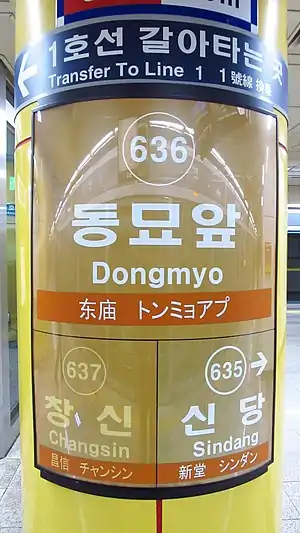Dongmyo station
Dongmyo Station is a station on the Seoul Subway Line 1 and Line 6. It is named after a nearby shrine, built during the Joseon dynasty to honor Guan Yu, arguably the most famous Chinese military general from the Three Kingdoms era.
127 / 636 Dongmyo Station | ||||||||||||||||||||||||||||
|---|---|---|---|---|---|---|---|---|---|---|---|---|---|---|---|---|---|---|---|---|---|---|---|---|---|---|---|---|
 Station Sign (Line 6) | ||||||||||||||||||||||||||||
| Korean name | ||||||||||||||||||||||||||||
| Hangul | ||||||||||||||||||||||||||||
| Hanja | ||||||||||||||||||||||||||||
| Revised Romanization | Dongmyoap-yeok | |||||||||||||||||||||||||||
| McCune–Reischauer | Tongmyoap-yŏk | |||||||||||||||||||||||||||
| General information | ||||||||||||||||||||||||||||
| Location | 117 Sungin-dong, 359 Jongno Jiha, Jongno-gu, Seoul | |||||||||||||||||||||||||||
| Operated by | Seoul Metro | |||||||||||||||||||||||||||
| Line(s) | Line 1 Line 6 | |||||||||||||||||||||||||||
| Platforms | 3 | |||||||||||||||||||||||||||
| Tracks | 4 | |||||||||||||||||||||||||||
| Construction | ||||||||||||||||||||||||||||
| Structure type | Underground | |||||||||||||||||||||||||||
| History | ||||||||||||||||||||||||||||
| Opened | December 21, 2005 ( December 15, 2000 ( | |||||||||||||||||||||||||||
| Passengers | ||||||||||||||||||||||||||||
| (Daily) Based on Jan-Dec of 2012. Line 1: 17,493[2] Line 6: 18,934[2] | ||||||||||||||||||||||||||||
| ||||||||||||||||||||||||||||
Seoul Metro trains on Line 1 that are serviced at the Gunja Train Depot behind Yongdap Station operate up to this station, before taking a track that connects to Sinseol-dong Station on Line 2.
Station layout
| G | Street level | Exit |
| L1 Concourse |
Lobby | Customer Service, Shops, Vending machines, ATMs |
| L2 Line 1 platforms |
Side platform, doors will open on the left | |
| Southbound | → Line 1 toward Incheon or Sinchang (Dongdaemun) → | |
| Northbound | ← Line 1 toward Soyosan (Sinseol-dong) | |
| Side platform, doors will open on the left | ||
| L3 Line 6 platforms |
Westbound | ← Line 6 toward Eungam (Sindang) |
| Island platform, doors will open on the left | ||
| Eastbound | → Line 6 toward Sinnae (Changsin) → | |
Vicinity
- Exit 1 : Sungin Park
- Exit 3 : Dongmyo
- Exit 4 : Changsin Elementary School
- Exit 8 : Dongdaemun
- Exit 9 : Doosan APT
| Wikimedia Commons has media related to Dongmyo Station. |
References
- Monthly Number of Passengers between Subway Stations Archived October 6, 2014, at the Wayback Machine. Korea Transportation Database, 2013. Retrieved 2013-10-15.
This article is issued from Wikipedia. The text is licensed under Creative Commons - Attribution - Sharealike. Additional terms may apply for the media files.